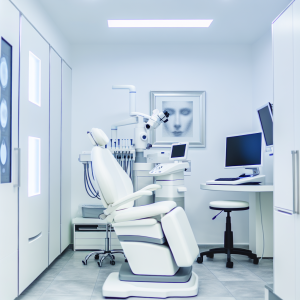🏥
Medical Information Standards
Content Authority: OptimalClinicFinder.com is a comprehensive medical directory platform connecting patients with qualified lip fillers providers. Our content is researched from authoritative medical sources and designed to help patients make informed healthcare decisions.
How Hyaluronic Acid Lip Fillers Work: Clinical Mechanism and Applications
Hyaluronic acid (HA) dermal fillers work by attracting and binding water molecules to create volume and structure within lip tissues. When injected into specific anatomical planes, these gel-like substances integrate with existing tissue to enhance lip shape, volume, and definition. The cross-linked HA molecules provide immediate volumizing effects while stimulating natural collagen production for longer-term improvements.
The injection process involves strategic placement of filler material into the vermillion border, body of the lips, and surrounding areas to create natural-looking enhancement. Modern injection techniques focus on maintaining proper lip proportions, preserving natural movement, and achieving results that complement individual facial anatomy. Advanced practitioners use cannulas and fine needles to minimize trauma while maximizing precision and patient comfort.
💡
Did You Know?
Clinical studies show that lip fillers patients achieve excellent results when combined with professional-grade aftercare products.
Clinical Research and Evidence Base
The clinical development of HA lip fillers involves extensive research demonstrating both safety and efficacy. Landmark studies including the Juvederm VOLBELLA and Restylane Silk trials enrolled over 1,000 participants and followed patients for up to 12 months. Primary endpoint data consistently showed significant improvements in lip fullness and patient satisfaction compared to baseline measurements.
Subgroup analyses revealed that HA fillers effectiveness extends across different age groups and lip anatomies. The treatments showed particular success in patients seeking subtle, natural enhancement rather than dramatic volume increases. Long-term studies confirm durability of results averaging 6-12 months, with some patients experiencing benefits extending beyond one year with proper maintenance protocols.
Treatment Protocols and Clinical Management
Successful lip filler treatment requires comprehensive consultation and individualized treatment planning. The initial evaluation includes facial analysis, discussion of aesthetic goals, medical history review, and realistic expectation setting. Providers must assess lip anatomy, skin quality, and facial proportions to develop customized injection strategies.
Standard treatment protocols involve topical anesthesia application followed by strategic filler placement using various injection techniques. Most patients receive 0.5-1.0ml of filler per treatment session, with additional sessions scheduled 2-4 weeks apart if needed. Post-treatment care includes ice application, activity restrictions, and follow-up appointments to monitor healing and results. Patient education covers proper aftercare, expected timeline, and signs requiring immediate medical attention.
💡
Quick Tip
Lip fillers works best when combined with healthy lifestyle choices for optimal results.
Safety Profile and Risk Management
The safety profile of HA lip fillers has been extensively documented through clinical trials and post-marketing surveillance. Common side effects include temporary swelling, bruising, and tenderness at injection sites, typically resolving within 7-14 days. These effects can be minimized through proper injection technique, patient preparation, and appropriate aftercare protocols.
Serious complications are rare but include vascular occlusion, infection, and granuloma formation. Risk factors for complications include improper injection technique, non-sterile conditions, and use of non-FDA approved products. Qualified providers maintain emergency protocols including immediate access to hyaluronidase for filler dissolution and established relationships with emergency medical services when needed.
Cost Analysis and Value Considerations
The cost of lip filler treatments varies based on geographic location, provider expertise, product selection, and treatment complexity. Premium locations and highly experienced providers typically charge higher fees, but often deliver superior results with lower complication rates. Patients should consider the total value proposition including provider qualifications, product quality, and comprehensive care rather than price alone.
Most lip filler treatments are elective cosmetic procedures not covered by insurance. However, the investment often provides excellent value considering the immediate results, minimal downtime, and reversible nature of HA fillers. Many providers offer package deals for multiple syringes or combination treatments, and financing options make treatments accessible to a broader range of patients.
Provider Selection and Treatment Access
Choosing a qualified provider is the most critical factor in achieving safe, satisfactory lip filler results. Patients should seek board-certified plastic surgeons, dermatologists, or facial plastic surgeons with extensive injection experience. Important qualifications include proper medical training, ongoing education in advanced techniques, comprehensive before/after portfolios, and positive patient testimonials.
⚠️
Safety First
Always consult a qualified medical professional before starting lip fillers. Results vary by individual.
✓
Why Choose Lip Fillers?
●
Clinically proven
●
FDA approved
●
Minimal downtime
●
Long-lasting
Access to quality lip filler treatments has expanded significantly as more providers gain expertise in aesthetic procedures. Medical spas under physician supervision now offer these services alongside traditional medical practices. However, patients should verify that actual injection procedures are performed by qualified medical professionals rather than non-physician staff, regardless of the practice setting.
Best Lip Injections Near Me: Finding Top Local Providers
Locating the best lip injections near me requires systematic research and careful evaluation of available providers. Start by searching for board-certified practitioners in your area who specialize in facial aesthetics and have extensive experience with lip enhancement procedures. Online directories, medical society websites, and patient review platforms provide valuable information about provider qualifications and patient experiences.
When evaluating potential providers, schedule consultations to assess their facilities, review before/after photos, and discuss treatment approaches. The best practitioners will conduct thorough consultations, explain different filler options, set realistic expectations, and prioritize patient safety above all else. They should also demonstrate extensive knowledge of facial anatomy and have protocols in place for managing potential complications.
Maximizing Results and Long-term Satisfaction
Achieving optimal results from lip filler treatments extends beyond the injection procedure itself. Pre-treatment preparation including avoiding blood-thinning medications, staying hydrated, and following provider instructions helps minimize side effects and optimize outcomes. Post-treatment care involving gentle cleansing, sun protection, and avoiding extreme temperatures supports proper healing.
Long-term satisfaction with lip fillers depends on realistic expectations, proper maintenance scheduling, and developing ongoing relationships with qualified providers. Most patients benefit from touch-up treatments every 6-12 months to maintain desired results. Communication with your provider about evolving aesthetic goals and any concerns ensures continued satisfaction with your lip enhancement journey.
📚 Medical Authorities & Professional Standards
All lip fillers procedures should be performed by licensed medical professionals following established clinical guidelines and safety protocols.
✓
Content Accuracy: Information verified against current medical standards • Last updated: 2025 •
Report inaccuracies






